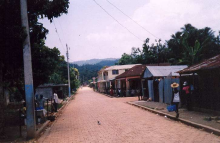 by Allison Archambault This is an excerpt from a Microgrid News article. Read the full article here. "The point of what we're doing is to prove out a viable business model that can be scaled and replicated throughout Haiti and the rest of world," says Allison Archambault, President of EarthSpark. That model is: deliver affordable, reliable energy services to homes and businesses in small towns with town-sized, solarized smart grids. We are optimizing for lowest levelized cost of electricity - when we do that, the generation is heavily renewable. Obviously these are site specific, but in many of the towns we envision for next steps, solar is a fantastic resource." EarthSpark has been running the grid project in Les Anglais since November 2012. The organization launched Haiti's first prepaid microgrid with just fourteen customers and has now expanded it to fifty-four - all of whom are now using second generation smart meters which are now being further developed by SparkMeter, a technology company that EarthSpark recently spun off to specifically focus on smart meter hardware and software. "We were looking for pre-paid meters with a low price point and a high degree of functionality," Archambault says. "We wanted to do things like change load limiting and remote connect / disconnect. There was nothing on the market that met our needs, so we developed our own." The grant received by EarthSpark will allow them to expand the project to approximately 400 customers, and to solarize the grid. "Right now the microgrid in Les Anglais is simply using diesel, which was never the long term plan," Archambault adds. "It was a simple way to get started, as we were collaborating with the local telecom company that was already using diesel for their communications tower." "Once the viability of the business model is proven, it should be able to be replicated elsewhere. Looking forward, we would not do a phased approach - we would go in and do a community / load assessment, alongside the government and local leaders, and design a town-sized energy system from the beginning." EarthSpark's notable innovation is its effort to pair residential and commercial loads in a viable business model through prepaid smart meters, seeking to provide demand management on a town-size scale in a way that makes the whole grid more efficient. After the Les Anglais project has proven out the business model, Archambault sees the integrated town-scale approach as replicable and attractive to investors. "Basically, we are taking one hundred years of people's experience managing power systems -- the lessons learned and the technology available now - and building the best possible system in these developing areas," she adds. "There is no incumbent infrastructure where we're building these grids. We're leapfrogging to the next generation, similar to what mobile phone operators did in these kinds of countries." This is an excerpt from a Microgrid News article. Read the full article here.
0 Comments
Earthspark named winner - "powering agriculture: a grand energy challenge for development"12/15/2013 by Allison Archambault
On Dec 11, USAID and its partners announced EarthSpark International as a winner of Powering Agriculture: An Energy Grand Challenge for Development. More than 475 organizations from 80 countries applied to the Powering Agriculture Grand Challenge in this inaugural round, offering market-based, clean energy innovations for the agricultural sphere in developing countries. Twelve winners were selected. The $1.1 million in grant funding will enable EarthSpark to expand its existing microgrid in Les Anglais to a town-sized, solar-diesel hybrid, smart grid to serve both residential and commercial customers, including agricultural processing facilities. The funding also supports local entrepreneurs in evaluating upgrades to existing and potential agricultural processing facilities in Les Anglais. Here is a summary of our proposal: Problem/Opportunity: In Haiti 75% of the country’s population lacks access to electricity, and farmers frequently lose the value of their crops for want of infrastructure and processing equipment. Where processing facilities do exist, they are typically diesel powered and expensive to operate. This imposes a severe limitation on farmers’ ability to process agricultural goods, capture the value of their products, and improve their livelihoods. Clean Energy Solution: EarthSpark will expand its existing electricity system in Les Anglais, adding solar generation and expanding smart controls, to deliver affordable, reliable, clean energy to community members, farmers and agribusinesses in a financially sustainable way. By providing technical guidance and facilitating access to financing for local partners, EarthSpark will assist agribusinesses with upgrading to efficient electric mills to modernize local processing for rice, sorghum, coffee, and corn. The project will specifically focus on highly nutritious breadfruit crops that typically rot due to lack of processing. Converting the fruit to flour or chips extends the shelf life by months and significantly increases the value and marketability locally, nationally, and abroad. Impact: By reducing agricultural waste and enabling value-added processing, the project will boost agribusiness incomes as well as provide surrounding residents with access to electricity, utilizing pre-pay smart meters. The project will demonstrate a sustainable business model for the local microgrid, for agribusiness’ upgrading to efficient electric mills, and for breadfruit processing. EarthSpark International is a US-based, non-profit organization with over four years’ experience working with communities, businesses, and government to bring energy access to Haiti’s un-electrified population. Through its local brand Enèji Pwòp, EarthSpark is an established and recognized brand in Haiti with the track record and infrastructure to scale up its clean energy and microgrid activities. 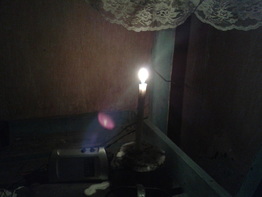 EarthSpark workdays often run well past sunset here in Les Anglais, and, lacking electricity in the homes and businesses that will soon be connected to the microgrid, we often use solar lamps to illuminate the final touches of a day’s installations. EarthSpark’s clean energy retail has been active in this town for over three years, and many families and businesses now light their homes with small-scale solar lights purchased from one of the local Enèji Pwòp (Clean Energy) retailers. In one home, however, a candle still illuminated the corner of a room where the microgrid home wiring was to take place. Entering the home, everyone paused to note the beautiful shadows the candlelight was throwing through lace curtains up into the rafters. Beyond the expense and the fire hazard and the eyestrain and the soot, there is something beautiful about candlelight. I asked if I could take a picture of the candle. Given the backdrop of the new electricity system being installed, it seemed a beautiful and poignant shot. There was even a moment of nostalgia – the dimly dancing shadows would largely disappear with the arrival of the grid when brighter, less expensive, safer light would be the new norm. The homeowner was happy to have a photo taken and stepped closer to his table, bumping it slightly. The bump set the candleholder rocking. Hot wax flew, and the five people crowded in the little wooden house watched as flame leaped menacingly toward lace. After what seemed like a slow motion fall, the thud of the candle hitting the floor extinguished the flame, and, in the darkness, the group sighed with relief at a house fire avoided. We turned on the solar lights to get to work on the home wiring for the soon-to-be launched smart grid. 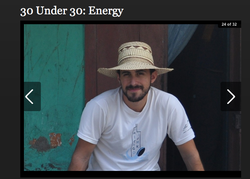 by Allison Archambault Congratulations to EarthSpark founder and Executive Director Dan Schnitzer for being names to Forbes’ 30 Under 30: Energy! Read more on the Forbes site. 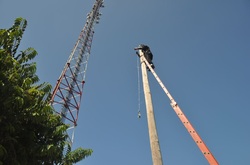 by Allison Archambault EarthSpark is launching Haiti’s first pre-pay microgrid in the small town of Les Anglais. Preliminary installation began in September, and we are presently continuing the installation so that the first customers will be able to turn on grid electricity in their homes by the end of November. A Haitian technician installs an insulator on a utility pole next to the Digicel antenna. The initial customer base is small—just 14 households—but the grid will demonstrate three things: 1. Prepayment is an effective way of managing billing for electricity services. (Prepayment is not a novel electricity billing approach, but it is new to Haiti. Most Haitians are already prepaying for their phone service.) 2. Deep efficiency can extend the value of electricity generation without increasing customers’ energy expenditures in the microgrid context. LED lightbulbs and other efficient end-user products require little electricity to deliver high-quality energy services. EarthSpark’s involvement throughout the value chain aligns incentives for these efficiencies to be optimally adopted. Finally, 3. The grid’s collaborative business model highlights how, by working with local businesses, a grid operator can lower operating costs for businesses while also opening up access to affordable, reliable electricity for households. A special thanks to National Geographic both for their financial support and for featuring this microgrid in this month’s print edition of National Geographic magazine! (page 9) Follow the installation progress on facebook and picasa. Near-term micro-grid expansion: bigger, smarter, greener While the initial grid in Les Anglais will serve as a viable grid and important demonstration, it is designed for expansion to cover all 400 homes and businesses in the Les Anglais downtown area. Phase Two of the Les Anglais microgrid will serve 400 customers, will integrate 93 kW of solar PV as a generation source along with battery storage, and will manage billing and SCADA with a small-scale smart meter system designed specifically for the BOP microgrid market. EarthSpark is actively fundraising for this expansion now. 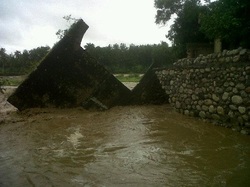 by Allison Archambault Though only a tropical storm when it hit Haiti, Hurricaine Sandy brought devastating floods and winds that tore down homes, reshaped rivers, and decimated crops. Throughout Haiti, the combined effects of the earlier drought and tropical storms Isaac and Sandy have erased 90% of this year’s locally produced food, so long-term effects of the storm will be felt at harvest time and beyond. Sandy hit the South especially hard. The Les Anglais river captured crops, homes, and animals and cut off passage to the communes in the western part of the peninsula for days. Thank you to everyone who contacted us with concern. Despite the devastation, things are moving back to normal. The river is again passable, and roads have been cleared. Like many victims of the flooding, Enèji Pwòp’s leading cookstove artisan, Jean Douyon, lost his home to flooding but is now living with his family in temporary housing and planning to build his home back stronger to resist future floods. The flooding has worsened because deforestation in the mountains for charcoal production leads to large storm surges in the lower river. Thus in a small way, the efficient cookstoves Jean produces for Enèji Pwòp are helping to address one of the macro factors that have led to these big floods. by Allison Archambault
EarthSpark International has been chosen as one of twenty social enterprises in this year’s Global Social Benefit Incubator at Santa Clara University. Now in its tenth year, the GSBI has built an alumni network of 139 award-winning social enterprises, most of which are scaling quickly and tackling some of the world’s biggest poverty and environmental challenges. EarthSpark is delighted to join such an esteemed network, and we look forward to the hard work ahead in the GSBI social entrepreneur ‘boot camp’ this summer! by Allison Archambault
Thanks to Frantz at Konbit for Port-à-Piment for incorporating kerosene and charcoal prices in the monthly Port-à-Piment market status reports on www.portapiment.com! Great to see the mention of www.enejipwop.com too! We look forward to comparing kerosene and charcoal prices across the region and also adding up savings for each region based on efficient cookstoves and solar lighting. 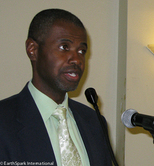 Dr. René Jean-Jumeau by Allison Archambault On January 23, Haitian President Martelly announced a new rural electrification program aiming to electrify 200,000 households in the next two years. The program, named “Ban m limyè, Ban m lavi” (BLBL, translated as “Give me light, give me life”) envisions a portfolio of approaches to electrification, including opening up access to end-user credit for small solar home systems. Dr. René Jean-Jumeau calls for bold innovation to electrify 200,000 Haitian homes in two years. While details have yet to be defined, the announcement is a clear signal that the highest levels of Haitian government are prioritizing energy access. Dr. René Jean-Jumeau, Secretary of State for Energy, pointed out that the state-owned national utility, EDH, recently celebrated 40 years of operation, yet less than 30% of the Haitian population has access to electricity. “We cannot wait another 40 years to get another 30% electrified,” Jean-Jumeau said. Both Jean-Jumeau and Martelly drew clear lines between economic growth and access to energy and called for innovation and public-private partnerships to fill the gaps currently left by EDH. 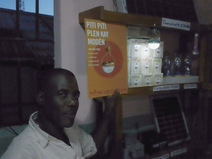 by Allison Archambault When stories are told in Haiti, often the storyteller warms up the audience with a series of well-know riddles. “Krik!” the storyteller yells to get everyone’s attention. “Krak!” the audience - or those paying attention - will yell back to show they are ready for the story. Gathering more interest, the storyteller often launches riddles. A popular one: “Piti piti, plen kay” (Very small, fills the house)? “Lanp!” (Lamp!) The Enèji Pwòp team has a variation on this well-known riddle. “Piti piti plen kay modèn?” (Very small, fills the house, is modern?) And the answer? An Enèji Pwòp Lamp, of course. This draws smiles and nods. “Aaaaah! Lanp Enèji Pwòp,” people agree, “Lanp modèn.” The Enèji Pwòp-branded Nokero N200s have arrived, and customers love them. While a typical kerosene lamp costs 200 gourdes to buy and 10 gourdes/night to operate, this Enèji Pwòp lamp costs 500 gourdes to buy and then needs no fuel, just exposure to sun to recharge the battery. Not only are families getting better light, reducing their exposure to dirty smoke and fire hazard, they are saving huge amounts of their household budgets. |
EarthSpark supporters make our work possible. Thank you for considering a donation towards eliminating energy poverty in Haiti.
Read the full blog - click here!
|
EarthSpark International is a non-profit 501(c)3 organization.
